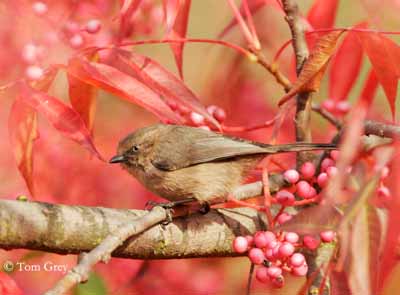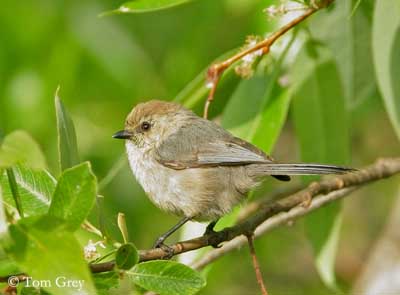
PROTECTION / THREATS / STATUS:
The Bushtit’s populations are not currently threatened. This species is fairly common throughout the range.
However, these tiny birds are vulnerable to hard and wet weather. They also are preyed upon by avian predators such as the Sharp-shinned Hawk.
Fr: Mésange buissonnière
All : Buschmeise
Esp : Sastrecito Común
Ital : Codibugnolo americano
Nd: Struikmees
Sd: Buskmes
Photographer:
Tom Grey
Tom Grey's Bird Pictures
Text by Nicole Bouglouan
Sources:
HANDBOOK OF THE BIRDS OF THE WORLD Vol 13 by Josep del Hoyo-Andrew Elliot-Jordi Sargatal - Lynx Edicions – ISBN: 9788496553453
BIRDS OF THE GREAT BASIN – by Fred A. Ryser - Univ of Nevada Pr -ISBN: 0874170796
A GUIDE TO THE BIRDS OF MEXICO AND NORTHERN CENTRAL AMERICA by Steve N. G. Howell, Sophie Webb - Oxford University Press - ISBN: 0198540124
FIELD GUIDE TO THE BIRDS OF NORTH AMERICA - National Geographic Society - ISBN: 0792274512
Bird Web (Seattle Audubon Society)
BirdLife International (BirdLife International)
Stanford University - Birds of Stanford
What Bird-The ultimate Bird Guide (Mitchell Waite)
Bushtit
Psaltriparus minimus
Passeriforme Order – Aegithalidae Family
BIOMETRICS:
Length: 10-11 cm
Wingspan: 18 cm
Weight: 4,5-6 g
DESCRIPTION:
The Bushtit is a North American long-tailed tit, the only member of the genus Psaltriparus.
The adult male has grey, washed olive upperparts. The fairly long tail is dark grey. The rectrices show paler grey edges, and the outermost tail feathers are fringed and tipped whitish. The upperwing shows various tones of grey.
On the underparts, chin, throat and centre of breast are whitish. The lower breast, belly and vent are pale buff-grey, with dull pinkish-brown wash on the rear flanks.
On the head, crown and nape are olive-brown washed grey. Lores, cheeks and ear-coverts are pale brownish, whereas the neck sides are light grey.
The short bill is black. The eyes are dark brown. Legs and feet are black.

The female is almost similar but she has duller plumage and white, cream or pale yellow eyes.
The juvenile resembles female but duller and with dark eyes.
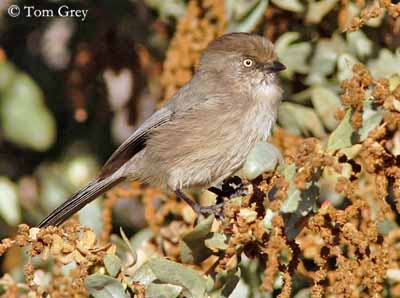
There are several subspecies which differ in colours tones and head pattern.
VOICE: SOUNDS BY XENO-CANTO
The Bushtit utters short contact calls, “pit” or harder “chip” varying in frequency and volume. These calls can be given singly or in long series.
When the bird is excited, it gives loud, nasal “stit”.
We can also hear high-pitched “see-see-see” or “sisisisi” in anxiety, if one bird is separated from the flock.
The alarm call is a protracted “silililililili” often given in chorus by several birds, and during about two minutes, especially when an avian predator approaches.
Between them at roost, they communicate with quiet twitter and soft contact calls.
This species has not territorial song.
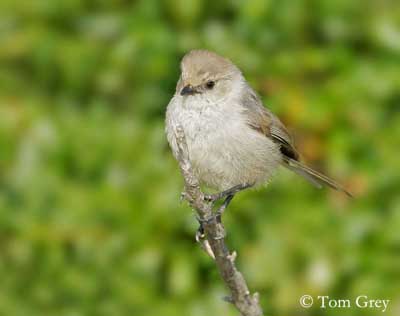
HABITAT:
The Bushtit frequents mixed forests in mountains (Quercus and Pinus), and mainly scrub in coastal regions. This species favours open mixed woodlands with evergreen parts or shrubby understory, and often avoids the pure coniferous woodlands.
But it also frequents the second growths, the canyon areas with large shrubs and small trees, and usually the shrubby habitats.
Outside the breeding season, the Bushtit often wanders into Fir forests at higher elevations, or also into desert areas, but it avoids the open desert.
This species can be seen from sea-level up to 1850 metres of elevation inland, and up to 3000 metres in mountainous habitats.
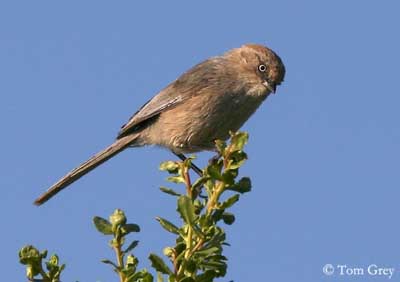
RANGE:
The Bushtit is mainly resident in W United States and high parts of Mexico, and occurs from Vancouver, through the Great Basin, lowlands and foothills of California to southern Mexico and Guatemala.
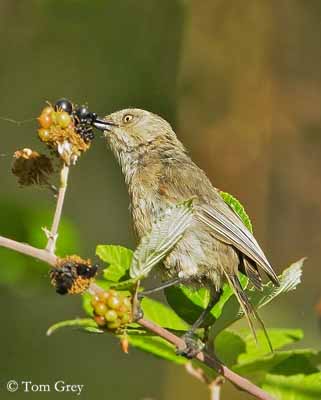
BEHAVIOUR:
The Bushtit remains in cover while foraging. It feeds mainly on small insects and spiders, but it also takes olives (Olea), the tiny seeds of Willows (Salix) and berries.
It forages along the thinnest supports and mainly in the outer parts of bushes and trees. It regularly hangs up upside-down and uses one foot to turn out the leaves in the foliage. The larger preys such as caterpillars are beaten before consumption.
The Bushtit is gregarious and is often seen in flocks of up to 40 birds all year round. These flocks include more or less the same members every year.
The social system of the Bushtit is very complex and varies from year to year but also according to the range. The breeding birds remain with the other members of the flock as well for foraging as for breeding. The nests of all the birds lie within a small “nesting home range”.
The area around each nest is weakly defended by the breeding pair in the early part of the season, but they do not defend the nest once the eggs are laid.
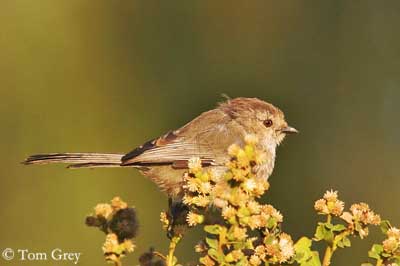
In some parts of the range, they perform co-operative breeding, and the pair allows other flock-members to take part in nest-building, incubation and feeding of the young. The helpers often are unmated adult males, but also adult male or female, or juvenile.
The displays begin in the flock, involving excited contact calls and posturing. The male chases the female and pecks at her tail base before to copulate.
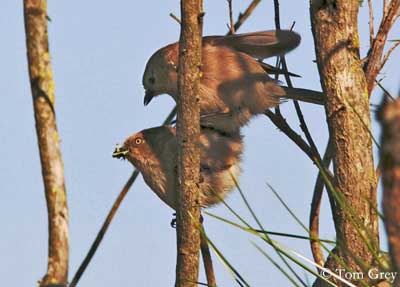
The Bushtit is mainly resident in its range, and only performs altitudinal movements.
In order to maintain the temperature of such tiny body during the cold nights, they roost closely packed together in a tight mass. They roost in the open but among dense branches.
The outermost birds often die, and some disputes can occur to get the best place in the middle of the row.
FLIGHT:
The Bushtit performs undulating flight with rapid wing-beats.
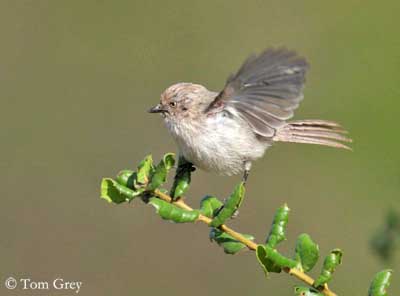
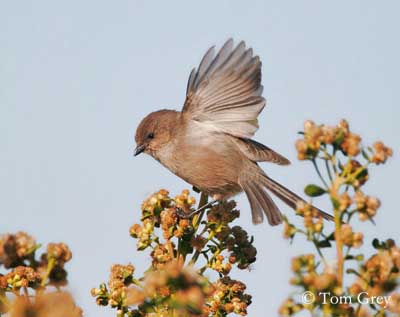
REPRODUCTION:
The clutches start in April throughout the range. The annual variations are due to weather conditions. This species usually produces two broods.
The pair selects the nest-site and builds the nest. This is an elongated gourd-shaped pendent nest. The top can be completely roofed over with an entrance in the “neck” of the structure. But the nest can also have the entrance at one side of the top, and be roofed over with a hood.
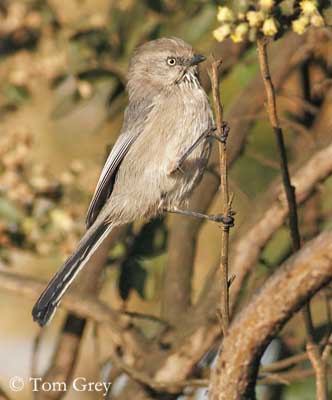
The nest is placed within a fork or between two parallel twigs. The birds build first a rim with nest materials tied together with spider webs. Then, they build a small bag beneath the rim and continue by working inside this bag, thickening the loose parts of the structure. The helpers can take part in building the nest.
The female lays 4-8 eggs. Larger clutches are the result of other females laying in the same nest. Both sexes incubate during 12-13 days, sometimes assisted by helpers in brooding and feeding of the chicks.
The young fledge about 18 days after hatching, or sooner (14 days) if disturbed. The fledglings are fed for two weeks more by parents and helpers.
The second clutch is laid in the same nest a few days after the first young fledge.
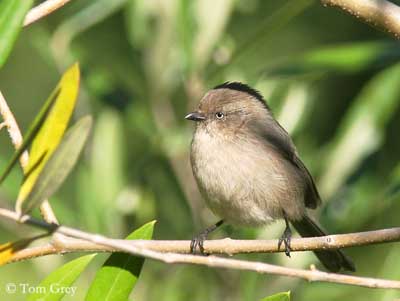
DIET:
The Bushtit feeds mainly on small insects and spiders, some vegetable matter such as the small seeds of willows, olives and berries. The larger preys such as caterpillars are beaten repeatedly against the branch before to be swallowed.
